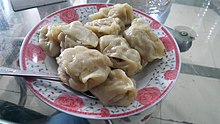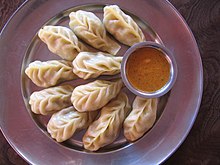Momo (food)
 A typical serving of a plate of momos with sesame yellow sauce and red ginger chilli pickle | |
| Alternative names | མོག་མོག, मःमः |
|---|---|
| Main ingredients | White-flour-and-water dough; meat, vegetable |
| Variations | Steam-momo, Kothey momo, Jhol momo, C-momo, Fry-momo, Open-momo, fried momo, chicken-momo, veg-momo, buff-momo, cheese-momo, khuwa-momo, chocolate-momo |
| 350 to 1000 (35 to 100 per piece) kcal | |
| Similar dishes | jiaozi, guotie, xiaolongbao, baozi, mantou, buuz, gyoza, mandu, manti |

Momos are a type of steamed filled dumpling in Tibet,[1] Nepal,[2] Bhutan and India.[3] Momos are usually served with a sauce known as achar with spices and herbs. It can also be cooked as soup versions known as jhol momo. The broth is made from achar using a mixture of tomatoes, sesame seeds, chillies, cumin and coriander or mokthuk from boiling pork or buffalo bones mixed with various herbs and vegetables.[4]
Production
[change | change source]

A simple white-flour-and-water dough is used to make the outer covering of momos. Sometimes, a little yeast or baking soda is added to give a more doughy texture to the finished product.
Traditionally, momos were made with ground/minced meat, potatoes, and leek filling. Momos are now made with almost any combination of ground meat, vegetables, tofu, mushrooms, paneer, soft chhurpi (local hard cheese) and vegetable and meat combinations.
- Meat: Different types of meat fillings are popular in different regions. In Nepal, Tibet, Sikkim, and Bhutan common meat fillings are pork, chicken, goat and water buffalo. In the Himalayan region of Nepal and India, lamb and yak meat are more common. Minced meat is combined with any or all of the following: onions/shallots, garlic, ginger and cilantro/coriander. Some people also add finely puréed tomatoes and soy sauce.[5]
- Vegetables: Finely chopped cabbage, carrot, soy granules, potato, flat bean (lilva kachori) or chayote (iskush) are used as fillings in Nepal.
- Cheese: Usually fresh paneer or the traditional soft chhurpi is used. This variety is common in Eastern Nepal.
- Khoa: Momos filled with milk solids mixed with sugar are popular as a dessert in the Kathmandu Valley.
The dough is rolled into small circular flat pieces. The filling is enclosed in the circular dough cover either in a round pocket or a half-moon or crescent shape. People prefer meat with a lot of fat because it produces flavourful, juicy momos. A little oil is sometimes added to the lean ground/minced meat to keep the filling moist and juicy. The dumplings are then cooked by steaming over a soup (either a stock based on bones or vegetables) in a momo-making utensil called mucktoo. Momos may also be pan-fried or deep-fried after being steamed.
Gallery
[change | change source]-
Momos in a mucktoo in Kathmandu, Nepal
-
Kothey, a pan-fried momo variety from "The Bakery Cafe" in Nepal
References
[change | change source]- ↑ Kleeman, Julie; Jampa, Yeshi. Taste Tibet: Family recipes from the Himalayas. Murdoch Books. ISBN 9781911668428. Archived from the original on 2023-05-05. Retrieved 2023-05-05.
- ↑ Shah, Santosh. Ayla: A Feast of Nepali Dishes from Terai, Hills and the Himalayas. DK. ISBN 9780241535776. Archived from the original on 2023-05-05. Retrieved 2023-05-05.
- ↑ Pushkarna, Kritika (2021-11-23). "The Interesting Story Of How Momos Came To India". TIMESOFINDIA.COM. Archived from the original on 12 May 2023. Retrieved 12 May 2023.
- ↑ "Anup's Kitchen | Traditional recipes, without shortcuts". July 8, 2016. Archived from the original on April 25, 2023. Retrieved April 25, 2023.
- ↑ "Momo recipe". Himalayanlearning.org. Archived from the original on December 1, 2008. Retrieved April 6, 2011.


